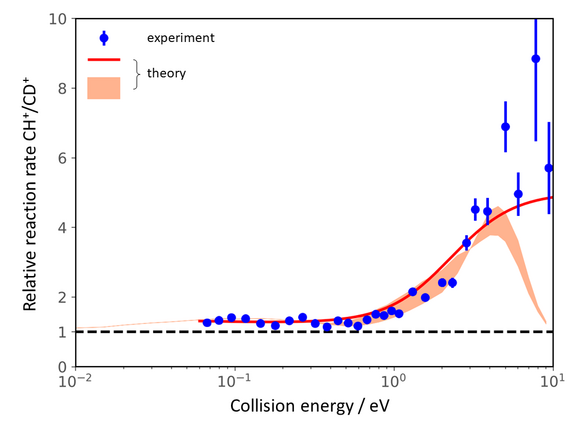Summary
- Cold ion-neutral reactions play a dominant role in interstellar chemistry.
- The Cryogenic Storage Ring (CSR) stores cold molecular ions under conditions resembling those found in interstellar space.
- Reactions between HD+ and neutral C atoms show an unexpected isotope effect – in accordance with new calculations.
Scientists of the MPIK in collaboration with groups from UCL Louvain-la-Neuve (Belgium) and the Observatoire de Paris (France) have used the recently commissioned ion-neutral collision setup at the Cryogenic Storage Ring (CSR) to study reactions between HD+ and H3+ ions and neutral carbon atoms. These reactions are of great relevance to the chemistry of the interstellar medium, where they introduce carbon into the chemical networks and thus serve as a gateway for the onset of organic chemistry in space.
The measurements with vibrationally cold ions carried out at the CSR result in significantly higher rate coefficients when compared with previous studies using internally excited ions. Furthermore, the new data reveal an unexpected kinematic isotope effect for the collisions between HD+ and C, where the lighter CH+ reaction product is favored over the slightly more stable CD+ product across all collision energies. These findings are supported by dedicated quasi-classical trajectory calculations carried out for the present study. The results have great significance for astrochemical studies, where isotopic ratios are often used to trace the chemical evolution of interstellar clouds.
The Cryogenic Storage Ring (CSR)
The Cryogenic Storage Ring (CSR) at the Max Planck Institute for Nuclear Physics is the largest of the new generation of electrostatic storage rings worldwide. With a circumference of 35 m and fully electrostatic ion optics, the CSR is suitable for carrying out detailed collision experiments with stored atomic and molecular ions, almost independet of their mass. The innovative, multi-layer cryogenic concept enables experiments at chamber temperatures of –268 ⁰C (or 5 K) and at an extremely low pressure of about 10–16 atmospheres. Atomic and molecular ions can be stored in an almost interaction-free environment for many minutes up to several hours (for heavier systems). The CSR is equipped with a low-energy electron cooler, a unique merged beams setup for neutral atoms and the first fully cryogenic reaction microscope, enabling a variety of experiments in the fields of molecular astrophysics and quantum dynamics of fundamental atomic and molecular reactions.
Original publications:
Merged beams study of the reaction of cold HD+ with C atoms reveals pronounced intramolecular kinetic isotope effect
Florian Grussie, Lukas Berger, Manfred Grieser, Ábel Kálosi, Damian Müll, Oldřich Novotný, Aigars Znotins, Fabrice Dayou, Xavier Urbain and Holger Kreckel
Physical Review Letters 132, 243001 (2024). DOI: 10.1103/PhysRevLett.132.243001
Absolute rate coefficient measurements of the reactions of vibrationally cold HD+ and H3+ ions with neutral C atoms
Florian Grussie, Lukas Berger, Manfred Grieser, Ábel Kálosi, Damian Müll, Oldřich Novotný, Aigars Znotins, Fabrice Dayou, Xavier Urbain and Holger Kreckel
Physical Review A 109, 062804 (2024). DOI: 10.1103/PhysRevA.109.062804
Weblinks:
The Cryogenic Storage Ring (CSR) at MPIK
Viewpoint article of APS Physics
Astrochemistry: A racetrack for ultra-cold molecules

